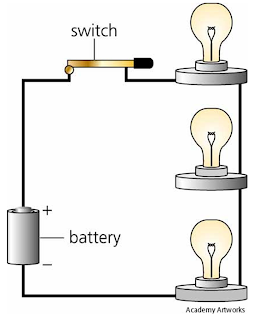The major difference between a parallel and a series circuit is in the way that the loads are connected. In a parallel circuit the loads are placed side by side.

In a series circuit however, the loads are connected one after the other in one path.
Each arrangement has an effect on the way in which potential difference and current act in the various parts of the circuit.
Kirchhoff's Current Law
The total of the current that flows into a junction point of a circuit is equal to the total amount of current that flows out of that same junction.
Kirchhoff's Voltage Law
The electric potential difference (voltage) of the battery (energy source) is equal to the total of the electric potential differences of the loads combined.
Kirchhoff's laws help us determine that in any circuit there is no net gain of electric charge or any net loss of energy.
In Class Challenge
Our class was split into groups of four and given an energy ball each.
My group could make the energy ball work by placing our finger over the hole that separated the two pieces of metal. The ball began to flash and hum because that way the circuit was completed.
A finger is a conductor. A metal is a conductor. By connecting the two pieces of metal with our fingers, we let the electrons flow and finish the circuit. We had to touch both metal ends, because by only touching one, the circuit does not complete.
The ball will not work if you connect the contacts with any material. For example, it will not work with glass, plastic, rubber, air, or wood. The material used has got to be a conductor of electricity.
The energy ball works with anything that allows electricity to pass through. The material has to be a good conductor, for example, silver, gold, copper, aluminium or any other metal. According to the results of the activity, human skin completes the circuit and allows electricity to pass and is therefore a good conductor.
The ball does not work on individuals who try to close the circuit with their hair or clothes. That is because water is lacking. Water acts as a conductor only when metallic solids are present in the water (so that the water is charged and the particles are free to move.) The ball might not work on individuals with a certain condition or disease or dehydration.
For more information see: Is water a conductor of electricity?
The ball lights up with all four individuals in my group if we connect the circuit properly (complete the circuit.)
With one energy ball we can create a simple circuit. All the parts are simply connected.
Given two balls we can create a circuit where both balls light up. We can form a series circuit.
if one person lets go of the other person's hand (while they are acting as a part of the circuit) they will act as a switch and make the ball go off.
It does not make a difference of who lets go of the other person's hand. Circuit is broken nevertheless, if it is a series circuit. In a parallel circuit it is possible to have one energy ball on and the other off.
It is possible to create a circuit where only one ball lights up. This can be achieved by making a parallel circuit.
The minimum number of people needed for this circuit is four.
Resources:


No comments:
Post a Comment